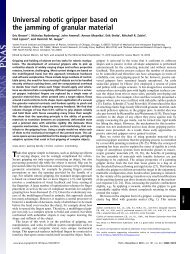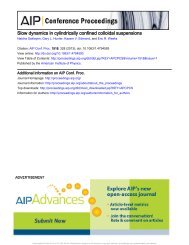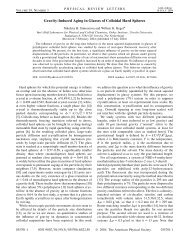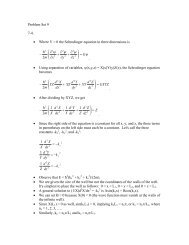Essay contest reveals misconceptions of high school ... - Genetics
Essay contest reveals misconceptions of high school ... - Genetics
Essay contest reveals misconceptions of high school ... - Genetics
Create successful ePaper yourself
Turn your PDF publications into a flip-book with our unique Google optimized e-Paper software.
<strong>Genetics</strong> Education 1167derstand these intricacies in the language <strong>of</strong> science.While we can infer that a student understood a topicbut was ineffective in the communication <strong>of</strong> that knowledge,this might be a leap that is ultimately damaging.Investigators have demonstrated that precise languageusage appears even more important in scientific fieldsbecause it is not merely a vehicle for communicatingunderstanding, but itself actively facilitates learningand comprehension (Connally and Vilardi 1989;Halliday and Martin 1993; Roth and Roychoudhury1992, 1993; Rivard 1994). It is reasonable to suggest thatwriting-to-learn strategies that are successful in otherdisciplines and levels should be considered for inclusionin the <strong>high</strong> <strong>school</strong> science curriculum. Unfortunately,some work suggests that the adoption <strong>of</strong> writing acrossthe curriculum programs—specifically those that engagestudents in scientific written discourse—is not widelyused in the United States, despite success in Australia andthe United Kingdom (Keys 1999).Implications for undergraduate biology education:Another interesting observation from our work is thatindividual teacher knowledge, interest, and bias wereclearly observed in student essays. Up to six studentsfrom a particular teacher could submit an essay to the<strong>contest</strong>. Frequently, similar themes were seen to runthrough many <strong>of</strong> the essays from a shared teacher–sponsor. For example, 3 essays in 2006 from the sameteacher noted an interest in studying ‘‘gene doping.’’Yet, <strong>of</strong> the 2443 other essays collected over 2 years, not asingle other essay mentioned this as a topic. Examplessuch as this reflect the critical influence individualteachers have on student interest, knowledge, comprehension,and possible misconception. Moreover, it isimportant to note that teachers were asked to submittheir ‘‘top’’ essays. While it is impossible to determine ifteachers vetted each essay prior to submission, it isreasonable to assume that many <strong>of</strong> the essays that weresubmitted were reviewed. Yet, 55.6% <strong>of</strong> essays reviewedexhibited a major misconception. This, in combinationwith the observation that student writing <strong>of</strong>ten clearlyreflected specific information learned in the classroom,implies that student writing might be indicative <strong>of</strong><strong>misconceptions</strong> held and perpetuated by the teachers.This conclusion has important implications for instructors<strong>of</strong> undergraduate biology and genetics courses.Most <strong>high</strong> <strong>school</strong> biology educators receive their trainingin genetics through their undergraduate courseworkin biology. Therefore, students are likely entering theirundergraduate courses with these <strong>misconceptions</strong> andleaving with the same <strong>misconceptions</strong>. Our work shouldprovide undergraduate science educators with the informationthey need to begin to eliminate the perpetuation<strong>of</strong> these <strong>misconceptions</strong>.Responsibility <strong>of</strong> scientists for marshaling change: Inaddition to scientists recognizing these <strong>misconceptions</strong>when they direct their classroom agenda at the undergraduatelevel, this research calls on those practicinggenetic research to adopt other changes in their communicationabout their research. Scientists must modelaccurate language and terminology usage when communicatingto their peers, the press, and the communityabout their own work and the work <strong>of</strong> others. <strong>Genetics</strong>has a precise vocabulary (e.g., it is a mutation in the cysticfibrosis gene, not the ‘‘cystic fibrosis gene,’’ that resultsin a disease phenotype), and scientists must ensure that<strong>misconceptions</strong> are not perpetuated through their ownmisuse <strong>of</strong> these terms.Another potential way for scientists to make significantinroads into correcting <strong>misconceptions</strong> at the K–12level is to dedicate themselves to spending time in theclassroom with teachers and students. Multiple programs<strong>of</strong>fer the opportunity for scientists to mentorclassroom teachers and students through either long- orshort-term experiences. Indeed, many different scientificdisciplinary societies foster such programs. Descriptionsand information about these programs can befound at http://hub.mspnet.org/. Scientists can usethese opportunities to promote accurate informationto students and teachers about the nature <strong>of</strong> theirdiscipline and scientific research. Unfortunately, thistype <strong>of</strong> work is <strong>of</strong>ten viewed as secondary to pr<strong>of</strong>essors’main responsibilities in their departments, especially inresearch-oriented departments. New programs must bedeveloped to encourage, promote, and provide infrastructuralsupport to scientists who dedicate themselvesto this type <strong>of</strong> work. Indeed, the National ScienceFoundation has recently funded one such programcurrently sponsored by a scientific society (http://www.genednet.org/pages/GENA_about.shtml).Challenges for change—Is it time to switch theparadigm? Gregor Mendel’s work is clearly among themost important in genetics. However, the relativelysimple view <strong>of</strong> one gene, one trait has yielded generations<strong>of</strong> students who can predict that ‘‘tt’’ will result in asmall plant and ‘‘TT’’ will result in a tall plant. Unfortunately,this monogenic view <strong>of</strong> the world, whileaccurate for a small subset <strong>of</strong> characteristics, is clearly alimited one. While students that have an understanding<strong>of</strong> genetics consistent with a ‘‘Mendelian model’’ reflecta certain depth <strong>of</strong> understanding <strong>of</strong> genetic disease, candescribe dominant and recessive patterns, and can graspthe concept <strong>of</strong> carrier vs. affected status (Hendersonand Maguire 2000), the reality is that the nature <strong>of</strong> mosttraits and human disease is more complicated than thismodel. Only a minority <strong>of</strong> state standards require thecoverage <strong>of</strong> alleles. Even in cases where dihybrid crossesare required per their inclusion in state standards, thisstill represents only monogenic inheritance <strong>of</strong> twoseparate traits (the tall, yellow pea plant vs. the short,green pea plant). But in the case <strong>of</strong> both traits, a singlegene contributes wholly to the observed (height orcolor) phenotype.Additionally, the requirement <strong>of</strong> teaching basic Mendeliangenetics likely is a factor contributing to student



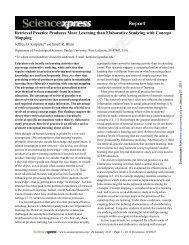
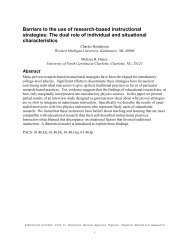
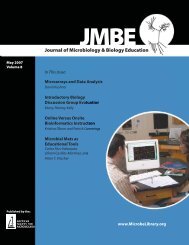
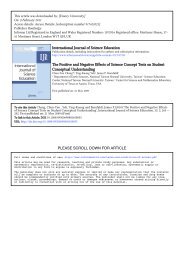
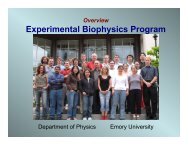
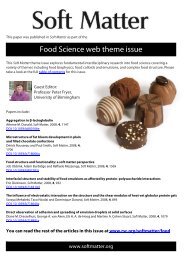

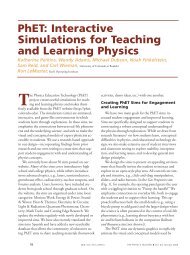
![view the Dish Show [PDF] - Department of Physics - Emory University](https://img.yumpu.com/45032745/1/190x146/view-the-dish-show-pdf-department-of-physics-emory-university.jpg?quality=85)

